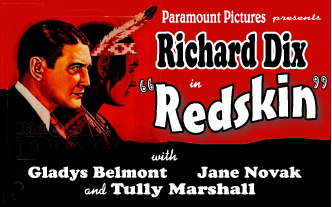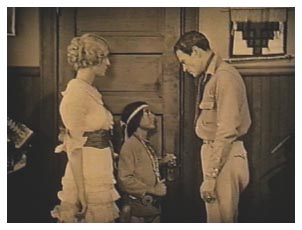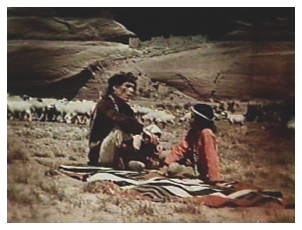

Paramount Pictures
Directed by Victor Schertzinger
Released February 23, 1929
Cast: Richard Dix (Wing Foot), Gladys Belmont (Corn Blossom), Jane Novak (Judy), Larry Steers (John Walton), Tully Marshall (Navajo Jim), Bernard Siegel (Chahi), George Rigas (Chief Notani), Augustina Lopez (Yina), Noble Johnson (Pueblo Jim), Joseph W. Girard (commissioner), Jack Duane (Barrett), Andrew J. Callaghan (Anderson), Philip Anderson (Wing Foot, age 9), Lorraine Rivero (Corn Blossom, age 6).
If you're a fan of the American Bard, Walt Whitman (and
shame, shame if you're not), take a minute to pull his Leaves
of Grass from the shelf and read "The Wound-Dresser."
Based in large part  on Whitman's own
experiences as a volunteer male nurse during the Civil War, this
short poem is a kaleidoscope of an elderly veteran's memories,
triggered by a haunting question from visiting youngsters: "What
deepest remains?"
on Whitman's own
experiences as a volunteer male nurse during the Civil War, this
short poem is a kaleidoscope of an elderly veteran's memories,
triggered by a haunting question from visiting youngsters: "What
deepest remains?"
Thus the corollary of any experience that touches our souls: what deepest remains. It's one we might apply to Victor Schertzinger's Redskin (1929), a film about a haunted and haunting Native American, for the episodes that linger with the viewer are those indelibly scarring the soul of the protagonist:
*Wing Foot, a Navajo chief's son, is forced to attend a government boarding school, where he is whipped for refusing to salute the U.S. flag. Humiliated, sobbing, he stumbles before his schoolmates (all Native Americans) and salutes, whereupon they descend in mockery and name him "Do-Atin" (Whipped One). He sits alone, head in hands, before Corn Blossom, a Pueblo, brings him candy and points to the flag, saying, "That's Uncle Sam, and he's going to take care of us"-- an irony subsequently not lost on Wing Foot or the viewer.
*Now a front runner on the university track team, Wing Foot attends a dance and is surrounded by students doing imitation tribal dances. One sneering classmate tells Wing Foot that he'd bet on him as he'd bet on a horse: the Navajo is tolerated on campus only because of his athletic prowess. Wing Foot replies, "My mistake was thinking I ever had a chance among you whites!", adding that "I'm going back to my people-where I belong!" As he prepares to leave, his roommate tries to assuage him with a ham-fisted compliment, saying that he "sure acted white-for a redskin."
*Back on his tribal land once more, Wing Foot is appointed the medicine man's successor but refuses, insisting that his people incorporate the white man's medical ways instead of relying on what he now takes to be witchcraft. The men of the tribe scorn him as, one by one, they kick sand on his medicine blanket. Wing Foot again is left alone, a pariah.
Redskin, included in the box set Treasures III:
Social Issues in American Film 1900-1934, was adapted by Elizabeth
Pickett from her novel Navajo and presents a man unable
to anchor himself in any  world,
a problem compounded by intertribal tension when he falls in love
with Corn Blossom. There's a contrived resolution to it all involving
discovery of oil, but as Scott Simmon notes in his superb essay
on the film, "Though plot is not Redskin's strong
suit, the issues faced by Wing Foot-about cultural assimilation
and racial identity-have not lost their currency."
world,
a problem compounded by intertribal tension when he falls in love
with Corn Blossom. There's a contrived resolution to it all involving
discovery of oil, but as Scott Simmon notes in his superb essay
on the film, "Though plot is not Redskin's strong
suit, the issues faced by Wing Foot-about cultural assimilation
and racial identity-have not lost their currency."
I want to quote Simmon at length here for his fascinating historical lead-in to the film:
Government policy since the end of the Indian wars in the 1880s had been unwaveringly in support of "amalgamation" of Native Americans into mainstream white society alongside "allotment" of tribal lands to individual Indians, a policy that culminated in the Indian Citizenship Act of 1924. But after the horrors of World War I-in which some 17,000 American Indians fought -- a contrary view was also rising in which European civilization had evident limits and tribal groupings had values worth preserving, if under a modern corporate governance model. The Problem of Indian Administration acknowledged an idea previously heretical in government reports: that some Indians did not wish to integrate into white society but instead sought to "preserve what they have inherited from their fathers." New possibilities for saving tribal cultures found federal support when President Hoover did what he rightly called a "thorough house-cleaning" of the Bureau of Indian Affairs in the spring of 1929, shortly after the release of Redskin. Central to the film is the choice between "assimilation" and "separatism" that all Indians, as newly recognized U.S. citizens, faced especially in these years. In Redskin Wing Foot's education makes him rootless in two cultures.
Thus the film's central questions --Who am I, and to whom do I owe my allegiance? -- have powerful resonance even today. Redskin doesn't bestow easy answers; though its resolution is too pat -- Wing Foot divides his wealth evenly between the Navajos and Pueblos and says, "Oh chief, I bring you not only a gift of the earth -- oil -- but the greatest gift of heaven -- tolerance!" -- we're left with ambiguity. If white society of 1929 is girded by insularity, so is that of the non-white world, with little hope of "passing" within either or moving from one to the other unscathed. That Redskin raises these questions at all, while providing perhaps the last sympathetic portrayal of Native Americans in cinema until the late 1940s, is reason enough for admiration. One remains in thought long after the screen has gone dark.
And I should add that it goes dark too soon, for Redskin is one of the most beautiful silent films ever made. Paramount filmed on location, and magnificent, God-given settings they are: Wing Foot lives in Arizona's Canyon de Chelly, while Corn Blossom dwells in New Mexico on the mesa of Acoma Pueblo. Simmon notes that "for the first thousand years of Acoma's habitation, the only route up its 300-foot sheer rock walls was by the hand-carved stairs seen in the film. But visitors to the pueblo today take the road carved in 1928 by Paramount for the film's heavy two-color Technicolor equipment." Yes, you read that correctly: color. Kevin Brownlow, in The War, the West, and the Wilderness, has no doubt that the film's visuals may be its chief glory:
Here the story takes second place to the magnificent
backgrounds and a strong documentary sense. Schertzinger was an
excellent director (and a noted musician), sadly ignored by film
history. Thanks to his sure hand, the action moves rapidly, and
there is no sense of posing or of proscenium direction. The color
in the original print is breathtaking; Redskin leaves an
impression of a kaleidoscope of awe-inspiring backgrounds, with
such much happening in the foreground that one hardly has time
to take in the whole frame. The color is used for emotional impact;
black and white (toned amber) represents the world of the white
man; color is reserved for scenes of Indian life.
Brownlow elliptically mentions what's really the sole frustration in watching Redskin: the mesas, cliffs, and canyons captured in this diamond-sharp print are so spectacular that one often looks beyond the actors, as it were, taking in the background with jaw-dropping wonder. (One of my students commented that watching the outdoor portions of the film was about as good as going on vacation.) And though none of the leading actors in the film are Native American, the "strong documentary sense" to which Brownlow alludes comes through not only in the location filming, but also in the rites and customs captured by Schertinzger. Future director Henry Hathaway, working here as assistant director, told Brownlow decades later about a problem the filming unit ran into:
"For one scene, we had to have a sand painting. The design is done with different colored sand, and it takes a long time. It took the Indians from early morning until 11:30. So we didn't get started until this late, and then found out we couldn't finish that day. According to Indian religion and custom, that sand painting could not be on the ground at sundown. It had to be destroyed. When I found this out, I offered them money, offered them anything they wanted to leave it there. No way. So finally I had a still photographer take a picture of it, and then we painted that out on a board and covered it with a little sand-and kept the camera back so that it looked as though the sand painting was still there."
If I've saved the performances for last, the simple reason is that, for the most part, they fail to register--not through any fault of the actors, I hasten to add. Now, Richard Dix, as Wing Foot, is wonderful: one truly feels the loneliness, shame, regret, and determination of a tortured soul looking for both vengeance and the peace that a sense of belonging affords. (One would never guess this same actor brought such a deliciously effervescent touch to his role in Gregory La Cava's romantic comedy Womanhandled (1925), included in Treasures 5: The West 1898-1938. Watch that one when you can: it's an absolute delight.) Philip Anderson, as young Wing Foot, and especially Lorraine Rivero, as young Corn Blossom, touch the heart with their vulnerability in the early scenes. But there's the problem: Wing Foot's shame at being whipped and labeled, and Corn Blossom's sweet sympathy to the sobbing boy, stay with and haunt the viewer. We're assured continuity as Dix carries the remainder of the film with his fiery rage against displacement, but you can see how the other actors, competent though they are, fade against his intensity. Brush that much aside: both for its gorgeous settings and for the hard questions it raises about cultural assimilation, Redskin continues to amaze and provoke.
And after the lights come up, we're still left pondering the damage done to a small child, the sense of other-ness, the scars that deepest remain in the mind of a lost soul wandering through burning sands. Robert Frost, writing about a very different landscape, captured something of the pain and isolation within:
Copyright 2013 by Dean Thompson. All rights reserved.